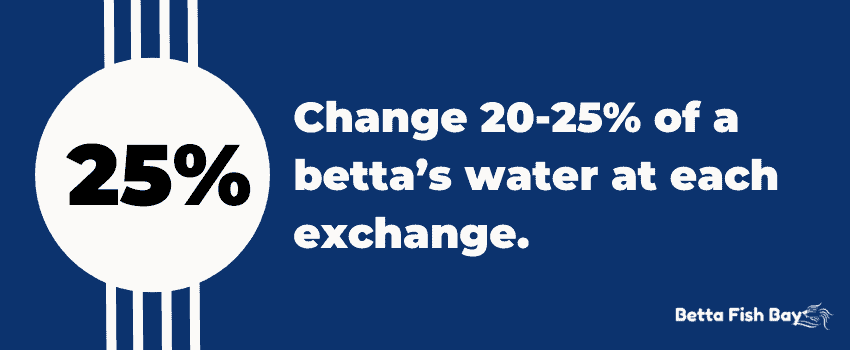Even though I first got a betta fish at 10 years old (a couple of decades ago) and have had them ever since, I still never heard the same answer to how often to change a betta’s water.
I asked experts and vets, and here’s the official and correct answer I found:
You must change your betta’s water once every 7 days and do a 20-25% water change each time. Don’t change all the water, or you’ll remove the healthy bacteria buildup in the water (it may end up killing your fish!). Also, condition any new water and bring it close to the proper temperature before putting it in.

Table of Contents
Why Proper Water Care Keeps Your Betta Fish Alive Longer
Betta fish are relatively hardy pets.
I remember one of mine as a kid living for four years despite the incidents happening when it was alive.
At one point, my much-younger cousin dumped an entire container of food into it at one time; we had to do an emergency water change without time to condition it.
While this toughness makes them great pets for beginners, the water parameters aren’t something to take lightly.
Betta fish get stressed just like any other animal, and this stress has the potential to be a huge problem.
In the short term, stress puts them into a fight or flight mode. They may even attempt to jump out of their tanks!
In the long term, stress will shorten their life expectancy dramatically.
Water care is the number one factor in stress and health in a betta’s life.
Many people, myself included, will even put diet secondary to the water conditions.
This is why checking water, keeping it just right, and changing the water out regularly are so critical.
Proper Betta Water Conditions
There is a lot of misinformation about the correct water parameters for betta fish.
We don’t want you to hurt your fish accidentally, so we did some research and asked vets to come up with these numbers.
Ideal Water Parameters for a Betta Fish Tank Include the following:
- Temperature: 78-80° degrees Fahrenheit (25.5-27° C)
- pH: 6.5-7.5
- Ammonia and Nitrite: 0 ppm
- Nitrate: < 40 ppm
- gH: 3-4 dGH (50-66.7 ppm)
- kH: 3-5 dKH (53.6-89.4 ppm)
- Minimum Tank Size: 5 Gallons
For more details, check out our betta fish water parameter guide.
It’s important to remember why we care so much about these specific parameters and where they come from.
Betta fish exist in the wild, though we think of them largely as pets in the modern world.
They are tropical fish, most known as native to the waters of Thailand.
They can survive in shallow, deep, slow, and stagnant waters most other fish can’t.
Unlike other fish, they don’t even need a lot of oxygenation in the water. Why? Because of their labyrinth organ.
This lets them also breathe air! (Which is why we see them gulping for air sometimes at the top of our tanks.)
But while this environment seems easy to meet, think about what slow-moving water in Thailand has:
- Higher temperature
- More bacteria
We need to focus on this in our water, which is why these parameters are the way they are.
How Often Should You Check The Water?
This is a question we’re often asked, and the answer isn’t easy to say.
For things like temperature, you must check on the water at least once daily. Even better would be to check it a couple of times per day or whenever you feed the fish.
Temperature shock is a significant and immediate danger to your betta.
This is exactly why we don’t recommend keeping the tank right near a window or by a vent.
The changes caused by sunlight, the heater, or air conditioning may cause a big jump. Truthfully, any change in a short period of over 5 degrees is dangerous to your betta.
All the other elements depend on how stable the water has been.
If you condition and change 20-25% of the water once per week, as we suggest, then checking once monthly is fine.
You’re already doing your part to keep the water in range by changing out old water for fresh water, so the elements should be more naturally stable.
But it would help if you upped the water checking when you either:
- Don’t change the water often enough
- Readings have been off recently
In these cases, you’ll want to check once every two weeks or even every week.
This is especially true if the water parameters have been way off. Keep an eye on it and consult a vet for more specific advice if needed.
Watch for the big three problematic chemicals: ammonia, nitrite, and nitrate.
How Often Should You Change Your Betta’s Water? (& What Affects It)
When I was a kid (decades ago now), we didn’t know the right way to change betta water.
I didn’t know how often to change it and how much to change.
As such, several of my bettas would pass away earlier than they had to.
But with the information we can share today, it’s easier to find answers.
It’s too bad not all of them are right. But this is why we check with experts, including veterinarians.
You need to change your betta fish’s water once per week.

Stretching it longer on occasion is OK, but it’s better not to wait.
The longer you wait, the farther off the levels get.
Specifically, the nitrate levels will start to rise. This gets dangerous if the levels get too high.
The pH and KH also start to drop, though it usually takes a little longer than the nitrate levels.
When it gets too low, your betta is in danger.
Low pH is commonly known as Old Tank Syndrome.
Biological filters fail in this case.
Interestingly, this won’t kill fish immediately if they’ve been in the tank the whole time.
However, new fish will die within hours or days in this type of tank.
Over time, the filter’s failures will cause other problems causing stress and possible death in your betta fish.
Change 20-25% of a betta’s water at each exchange.

The exact number has been hotly debated, and there isn’t a specific and correct number, but if you stick within this range, you’ll be just fine.
If the tank parameters are in the right spot, a 20% exchange is fine. Consider a 25% or even 30% exchange if the nitrates are high.
In general, you don’t want to go much higher than this at one point (except in rare cases). You’re taking too much of the beneficial bacteria when you do.
Lower, and it won’t make the difference you want it to. Over time, the levels will get off.
Whatever water you exchange needs to be treated with a water conditioner first. This removes problematic chemicals from the water.
All this being said, some factors affect this number (usually in the more frequent direction).
We’ll go into them in the next section.
Feeding Frequency
Bettas don’t need to eat a ton, and overeating is often a big problem with new betta fish owners.
It’s not because they’ll get fat. Bettas are pretty good at stopping when they’re full.
But leftover food doesn’t just dissolve into nothing. It affects your tank.
Specifically, leftover food directly increases ammonia levels in the water.
No, you’re not leaving your pet a “snack for later” when you leave extra food. It starts to break down and dissolve or rot right away.
Most of the time, your betta won’t come back for it at all.
Always remove uneaten fish food when they’re done eating.
On top of all this, feeding a betta a lot of food will increase the amount of waste products it produces.
This is just a fancy way of saying more food equals more poop.
This also increases ammonia and causes problems in the long run.
If you feed them often or notice a lot of waste, you’ll need to increase the frequency of water changes.
You must also clean the bottom of their tank with a suction hose to remove excess waste.
Food Type
The type of food affects the water, similar to the previous section.
Fish flakes and other easily-dissolved foods should be used sparingly. Or at least use only as much as your betta will eat.
If they dissolve quickly, they rot quickly. And they probably also have higher levels of ammonia and preservatives anyways.
Pellets are a better option as far as prepared betta food goes.
They take longer to dissolve, are easier to count, offer your fish a controlled diet, and are simpler to pick up after.
With betta pellets and others like it, simply get in there with your net and take them out when the betta is done eating.
Live food often provides the best effect on your tank. Some may even clean up some of the algae and waste your betta leaves behind!
But this isn’t always the case if there are too many. Sometimes, they’ll add to the waste too quickly and raise ammonia this way.
Either way, it’s something to consider when picking the type of food for your betta fish.
Types Of Filters
Of course, your filter will have a massive impact on the levels of the tank and how much you need to change the water.
A high-quality and new filter will keep levels stable, especially the dreaded ammonia, nitrite, and nitrate.
However, as the filter ages (or if you get a bad one), it’ll be able to handle the water less.
This is where the monthly checks come in.
It’s also where the weekly partial water change helps too!
Sponge filters with some carbon filtration processes built in are often considered the best.
If you use one, it can lengthen the time between water changes a little.
One common myth about filters is how live plants, like the spider vine, will help filter the water.
This is true, but only partly.
A spider vine will decrease undesired elements in the water, but it’s usually not enough to keep it safe over a long period.
However, if you have one and the water is stable, you may be able to switch to a change every two weeks!
The vine doesn’t impact the pH or KH as you’d think. You won’t be able to remove partial water changes from your routine altogether.
Aquarium Size
Tank size affects the water variability too.
Smaller tanks look easier to handle. They take up less space, have less water, and require less energy and power to filter and heat.
But as far as water changes go, smaller tanks mean more changes.
The less water there is, the more little changes will affect the whole tank.
Our measurements for ammonia, nitrite, and nitrate above are measured in “ppm” or “parts per million.”
This means it’s relative to the amount of water. A high amount in a small tank may be an acceptable amount in a larger one!
Larger tanks often require less change (though more work when it needs it!).
Keep this in mind, and pay attention to your monthly checks. If you want to change water less often, give it a shot but watch your data.
Tank Mates
I touched on this a little above, but the live animals in your tank also may affect how often you change your water (for better and for worse!).
A good algae eater will also remove some waste levels and help keep levels stable.
Another regular fish won’t. Their fish waste will add to the issues and increase the need for changes.
However, unless you’re overcrowding your tank, you ought to be able to keep with the weekly 20-25% frequent water changes.
But if you get a good, clean tank mate, you might be able to lengthen it to two weeks.
Again, we always recommend checking the levels to ensure nothing fishy (see what I did there?) is going on with the parameters. But many folks report being fine with some good algae eaters every two weeks.
A few good options include:
- Nerite Snails
- Amano Shrimp
- Ghost Shrimp
- Cherry Shrimp
- Siamese Algae Eaters
- Clown Plecos
Read our article on great algae-eating betta tank mates for more ideas and descriptions of each one.
Changing Your Betta Fish’s Water: A to Z
Don’t contaminate your betta or poison it accidentally. Read our brief guide on changing the water for your betta fish.
What You’ll Need
- Siphon hose / Clean cup / Clean container
- Dechlorinator or Water conditioner
- Clean bucket or large bowl
- Thermometer
A siphon hose like this is great for smaller tanks and will make your life much easier!
Steps To Change The Water
#1 Get The New Water
First, calculate the amount of water you’ll need. Divide the capacity of your tank water by 4 to get 25% of the volume.
If you have a 10-gallon tank, you’ll need 2.5 gallons of water.
This is where you’ll have to decide if you want to use a bucket or large bowl.
Fill up your container with the amount of water needed.
Use your thermometer to measure, and get the temperature between 78-80° degrees Fahrenheit (25.5-27° C).
If it goes under by two degrees or over by up to five degrees, it’ll be OK. But keep it as close as possible to avoid temperature shock.
Add cool water if it’s too hot or warm water if it’s too cool.
#2 Treat The New Water
Not all water quality is safe.
Use your dechlorinator and/or water conditioner as described on the package to make the regular water safe for your betta fish.
Please don’t ever skip this step.
There’s no faster way to kill a betta than to use water with a little chlorine. This is common in “city water.”
Even well water (like at my house) may have unsafe levels. The conditioner will take care of it for you and make it safe.
All tap water must be treated. Though, it won’t hurt to do it with all water.
When the water is ready, it’s time to move onto the next step.
#3 Remove Old Water 20-25%
Use your siphon or clean cup to remove 20-25% of the water from your betta’s aquarium.
Avoid disturbing the betta as much as possible. You don’t want to stress it out.
Dispose of the water.
#4 Add New Water
Slowly and calmly add the new water to the tank. Again, your goal is to avoid disturbing the betta as much as possible.
#5 Monitor For Stress
You’re pretty much done!
Now, you need to watch your betta for signs of stress.
It may not eat for a day after a water change. This is perfectly fine.
We recommend not feeding them within 12 hours of a water change.
Most of the time, they’ll still be a little stressed and won’t eat anyway. Any food you put in there and they leave behind adds to the ammonia levels anyway.
It defeats the purpose of the water change in the first place!
After this, all should be well!
Signs of stress include:
- Swimming spastically
- Crashing at the bottom of the tank
- Hiding excessively
- Stress stripes
- Refusal to eat
- Jumping out of the fish tank
These are signs something else may be wrong. Consult your vet for advice.
Get The Water Changes Right (Or Your Fish Will Suffer)
There is no better way to keep a betta healthy and happy than to keep its water stable and at the correct levels.
And the number one way to maintain this quality is to change the water to the correct frequency.
Doing a partial 20-25% change weekly will be enough to avoid significant problems and keep your betta safe for years.
If you thought this was helpful, share it with your fellow fish keepers so they can keep their bettas happy too!


